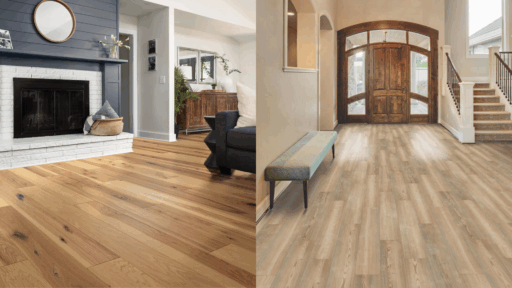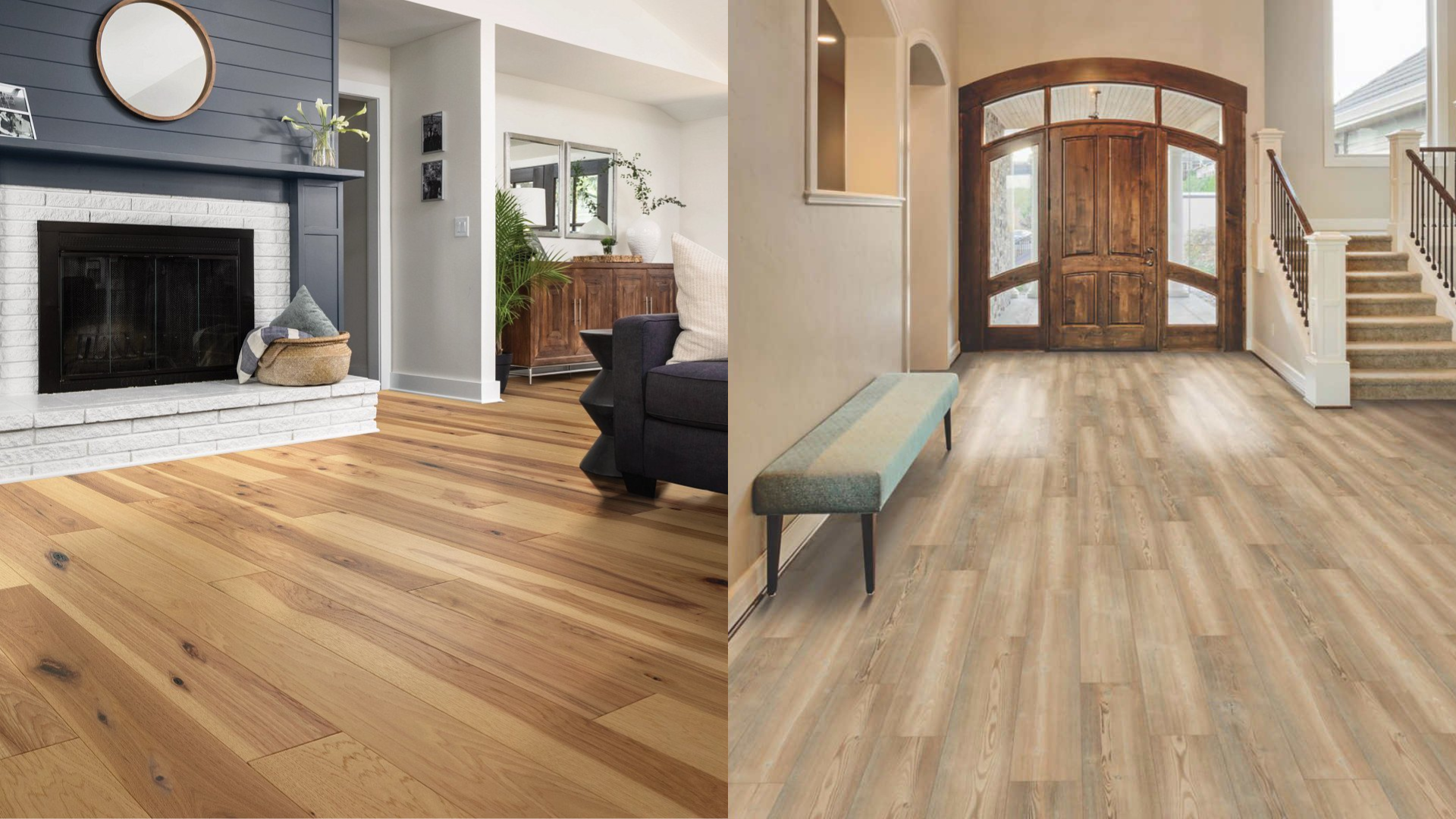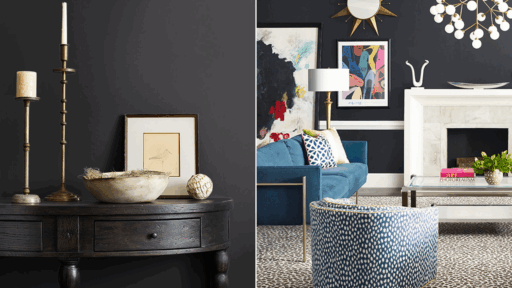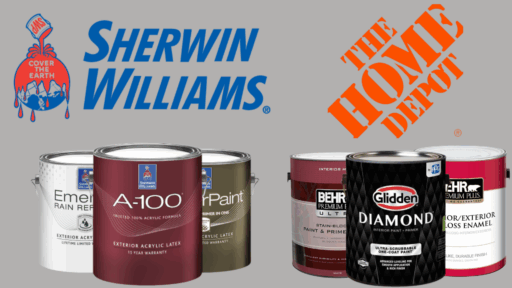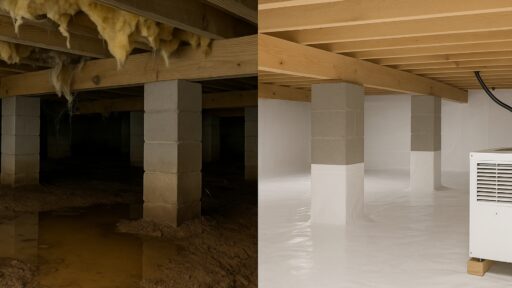Choosing between engineered hardwood and luxury vinyl plank (LVP) flooring was something I struggled with, too.
Both look great and can really change the feel of a room, but they’re very different when you dig deeper.
I wanted something that looked like real wood but could also handle daily life – pets, spills, and kids running around.
That’s when I realized a lot of people are asking the same question: Which one is better for my home?
In this blog, I’ll walk you through everything I learned – what makes each one special, what the costs are like, and what real people are saying.
If you’re stuck between the warm charm of engineered hardwood and the tough, budget-friendly appeal of LVP, this guide is for you.
I’ll keep it simple and share honest pros and cons so you can make the best choice.
Understanding Engineered Hardwood and LVP
If you’re picking new floors, you’ve probably heard about engineered hardwood and luxury vinyl plank (LVP).
At first, they might seem similar because they both come in planks and can look like real wood. But they’re actually pretty different.
Engineered hardwood is real wood on top with layers of plywood underneath. It gives you the beauty of hardwood but is a little more stable when the weather changes. It’s not as soft as solid wood, but it still feels and looks like the real deal.
LVP, or luxury vinyl plank, is made from plastic. It’s built to look like wood, but it’s waterproof, super tough, and easy to clean. If you want something low-maintenance and strong, this might be your winner.
Knowing the basics can help you choose what fits best in your home and lifestyle.
Key Features of Engineered Hardwood vs LVP
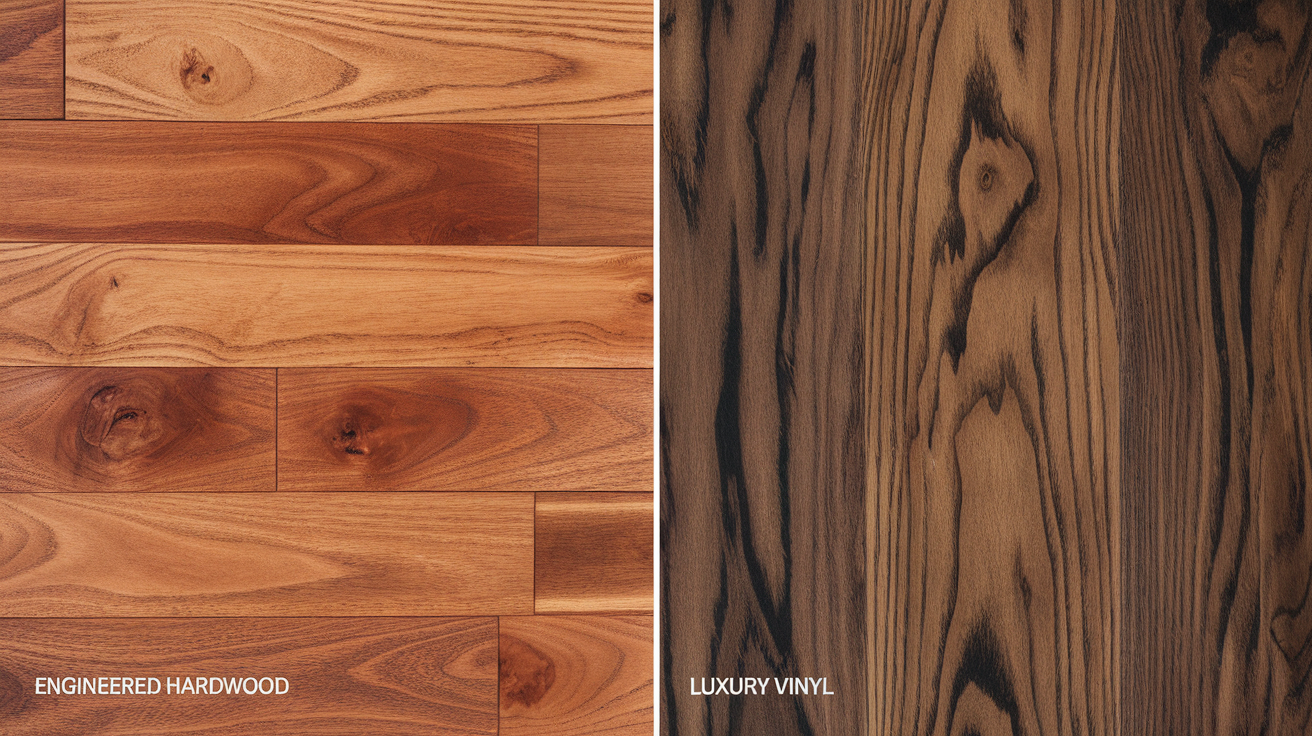
Let’s break down the key features of engineered hardwood and LVP so you can really understand how each one works in a home. I’ll go into detail for each feature and share what I’ve learned along the way.
1. Appearance
Engineered hardwood has a real layer of wood on top, so it looks and feels just like solid hardwood.
You get that natural grain, knots, and color changes that only real wood can offer.
No two boards are exactly alike, which gives them a warm, classic look. Many people (including me) love it because it adds a high-end feel to any room.
It’s great if you want something that feels traditional, cozy, and timeless.
LVP has a printed image of wood on the surface. Thanks to new technology, it can look very realistic.
Some LVP planks even have texture, like wood grain, to feel more natural under your feet.
While it’s not real wood, most guests probably wouldn’t notice unless they looked closely. It’s a good option if you like the wood look but don’t need the real thing.
2. Water Resistance
Engineered hardwood handles moisture better than solid wood, but it’s still not waterproof. If water sits on it too long, the boards can swell, stain, or even warp.
That’s why it’s not the best choice for bathrooms or basements.
In kitchens, it can work if you’re careful and clean up spills quickly. I’ve learned that keeping a dry mop nearby really helps.
LVP wins big in this area. Most types are fully waterproof, so they’re perfect for bathrooms, basements, laundry rooms, and kitchens.
You don’t have to panic if someone spills juice or the dog knocks over the water bowl. This is one of the main reasons people with pets or kids often pick LVP.
3. Maintenance
Engineered hardwood needs a little more care. You should sweep or vacuum often to keep dirt and grit from scratching the surface.
You’ll also want to use a wood floor cleaner instead of just water.
If it gets scratched badly, it can be sanded and refinished, depending on how thick the top layer is. That’s nice if you want your floors to last a long time and stay looking fresh.
LVP is super easy to take care of. You can sweep, vacuum, or even mop it without worry. No special cleaner is needed – just something safe for vinyl.
It’s very scratch-resistant, so you don’t have to stress about shoes, pets, or moving furniture.
This is a big reason why I often recommend it to friends with busy households.
4. Durability
Engineered Wood is pretty strong and holds up well with the right care. However, it can scratch or dent if something heavy drops or drags across it.
Over time, it may show wear in high-traffic areas, especially if it’s not cleaned regularly. Still, it can last for decades if treated right and refinished when needed.
LVP is made to be tough. It doesn’t scratch easily, and it’s super resistant to dents and wear. That’s why it’s used in both homes and businesses.
I’ve seen families with dogs and wild toddlers choose LVP and say it still looks brand new after years. It’s perfect if you want something that can handle heavy daily use.
5. Installation
Engineered Hardwood usually needs to be nailed, glued, or stapled down. Some types can float over a subfloor, but many still need professional help.
It’s not the easiest DIY job unless you have experience. It’s best installed over a smooth, dry surface, and some people add underlayment to reduce noise.
LVP is made for DIY. Most versions have click-lock edges that snap together easily. You can install it over many surfaces, even old floors, without much preparation work.
It’s lightweight, simple to cut, and doesn’t need glue or nails. I’ve helped a friend lay it down in a weekend, and it looked great by the end.
6. Price
Engineered hardwood is more expensive than LVP. You’ll usually pay more for the materials and for installation.
But for some people, that real wood feel is worth it. It can also increase home value, which is nice if you plan to sell later.
LVP is much more affordable, both in material and installation.
Even the higher-end options cost less than engineered wood. If you’re on a tight budget or need to cover a large space without breaking the bank, LVP is a solid pick.
These features are what really separate engineered hardwood and LVP. Both have their strengths and weaknesses, so think about what matters most to you – style, strength, price, or water resistance – and use that to guide your choice.
Best Applications of Engineered Hardwood vs LVP
When I was choosing between engineered hardwood and LVP, I realized that where you put the flooring matters just as much as how it looks.
Where Engineered Hardwood Works Best
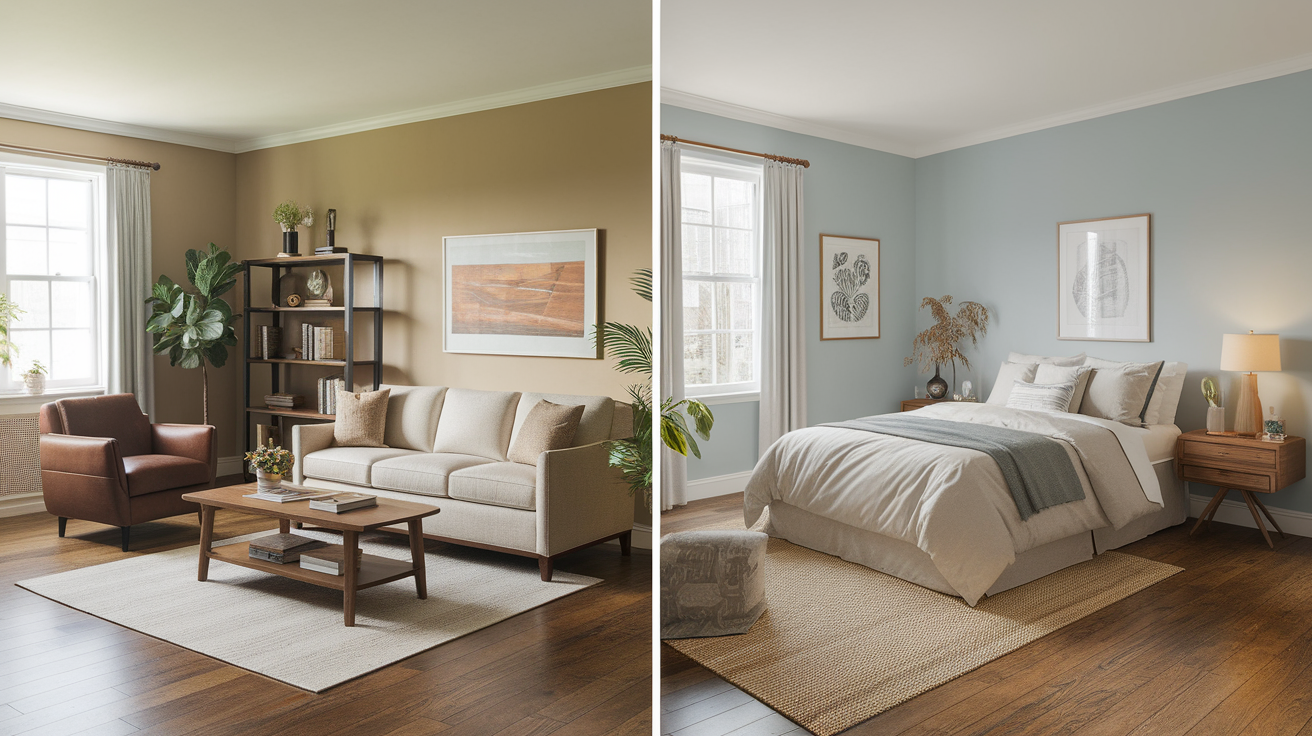
- Living Rooms and Family Rooms: Great for cozy, stylish spaces where moisture isn’t a concern and you want a warm, real-wood feel.
- Bedrooms: Ideal for low-traffic, dry areas where comfort and a classic look matter most.
- Avoid in Bathrooms and Basements: Not a good fit for wet or humid areas since it can swell or warp over time.
Where LVP Works Best
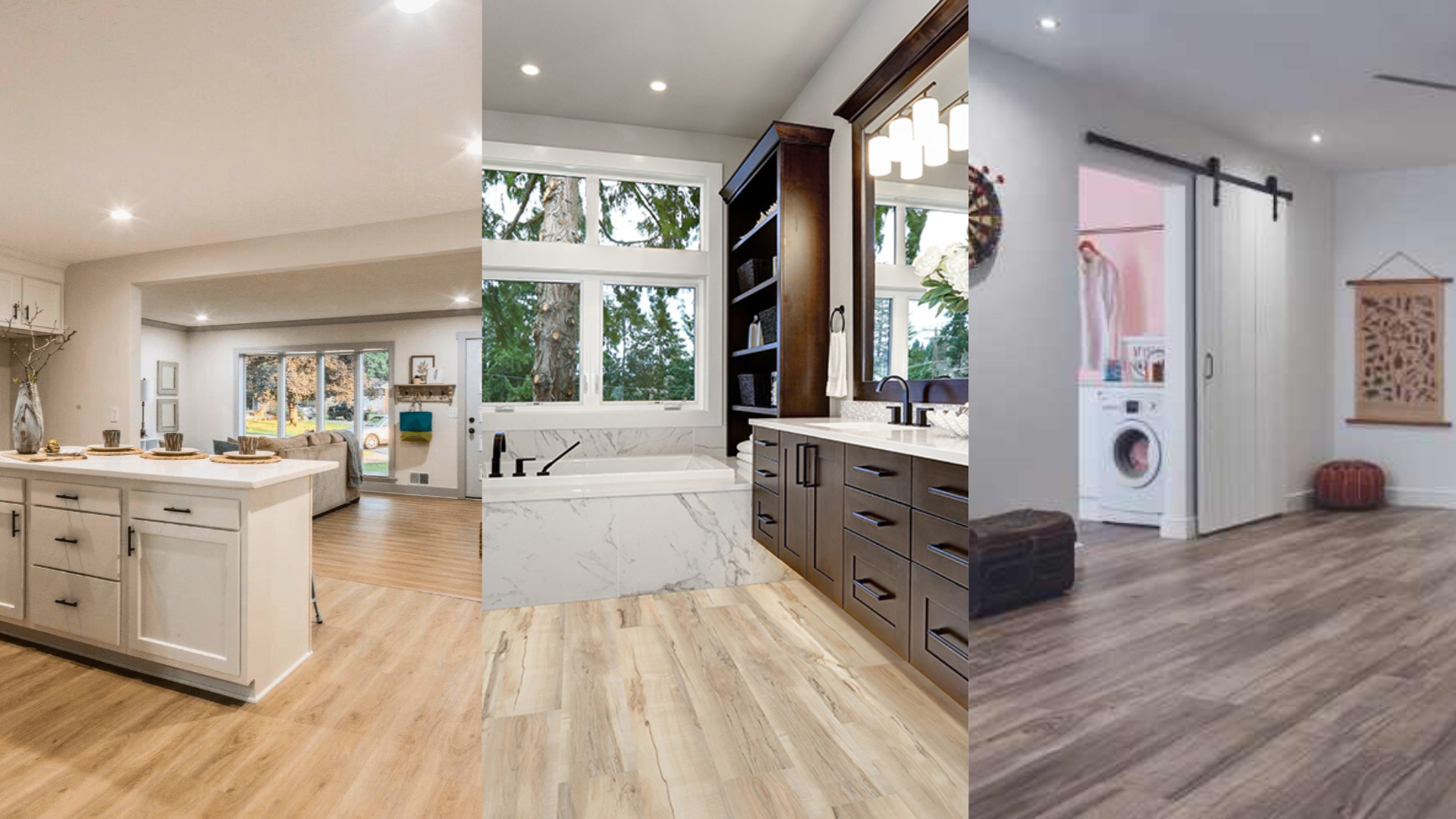
- Kitchens: Handles spills and foot traffic with ease, and it’s comfortable to stand on for long periods.
- Bathrooms and Laundry Rooms: Perfect for wet zones – it’s completely waterproof and won’t get damaged by moisture.
- Basements: Works well over concrete and in damp conditions where real wood wouldn’t survive.
Thinking about how each room is used really helped me make the right choice. Once I matched the flooring to the space, everything just came together.
Engineered Hardwood vs LVP: Pros and Cons
Here’s a quick look at the pros and cons of engineered hardwood and LVP to help you decide faster.
Engineered Hardwood
| Pros | Cons |
|---|---|
| Real wood surface gives a natural, high-end look | Can scratch or dent more easily than LVP |
| Can be refinished (if the top layer is thick) | Not fully waterproof – can be damaged by moisture |
| Adds value to your home | Usually costs more than LVP |
| More stable than solid hardwood in changing temps | Professional installation often needed |
Luxury Vinyl Plank (LVP)
| Pros | Cons |
|---|---|
| Fully waterproof – great for bathrooms, kitchens, basements | Can look less authentic compared to real wood |
| Very durable and scratch-resistant | Can’t be refinished if damaged |
| Easy to install, even as a DIY project | It may not add as much resale value as real wood |
| Budget-friendly compared to wood flooring | Lower-end options can feel less sturdy or look too fake |
These tables helped me weigh what mattered most for my home: looks, budget, or durability. Seeing it laid out like this made the decision a lot clearer.
Real User Experiences: Engineered Hardwood vs LVP
When I was deciding between engineered hardwood and LVP, I spent hours reading reviews and forum posts. Real people sharing their stories helped me see what to expect in everyday life, not just what brands advertise.
Engineered Hardwood
Many homeowners say they love the rich, natural look. It makes their homes feel warmer and more inviting. Some mention how impressed guests are when they find out it’s not solid hardwood.
However, users also point out that it scratches more easily, especially in homes with pets or kids. A few people said they regret not choosing something more durable for high-traffic areas.
LVP
LVP fans are quick to talk about how tough and easy it is. People with kids, dogs, or rental properties often praise it for standing up to messes, spills, and rough use.
Some even say it still looks brand new after years. A few wish it looked more like real wood, but most agree that the convenience is worth it.
Reading these real opinions helped me realize what mattered most for my own lifestyle – and I’m glad I took the time to listen.
Conclusion
After comparing engineered hardwood and LVP in detail, I realized there’s no one-size-fits-all answer. It really depends on your lifestyle, budget, and what kind of look you want in your home.
Engineered hardwood offers the warmth and charm of real wood, which feels special in bedrooms and living rooms.
On the other hand, LVP is tough, waterproof, and easy to clean – perfect for bathrooms, kitchens, and busy homes with pets or kids.
I looked at the pros and cons, read what real users had to say, and thought about how each space in my home is used. In the end, that’s what helped me make the right choice.
I hope this guide helps you do the same. Take your time, consider your needs, and don’t be afraid to mix the two if it fits your home better.

